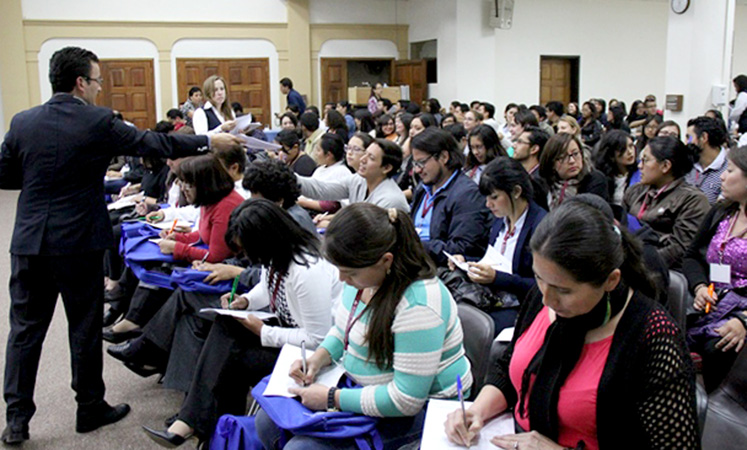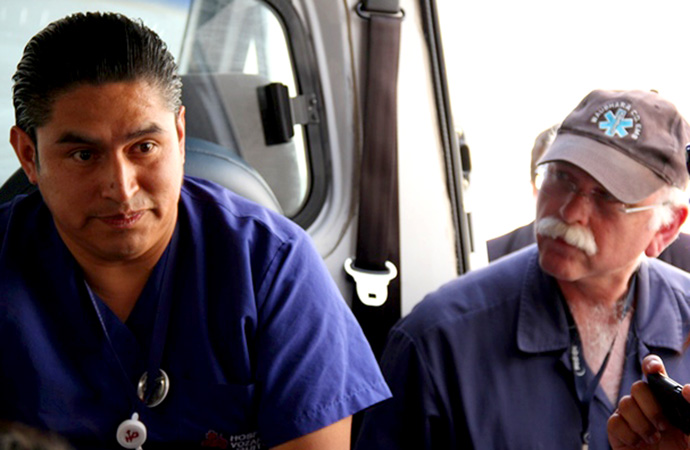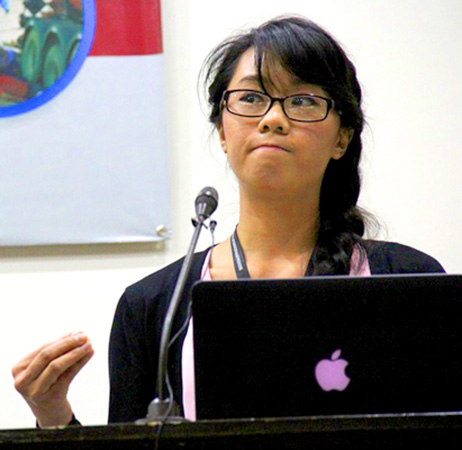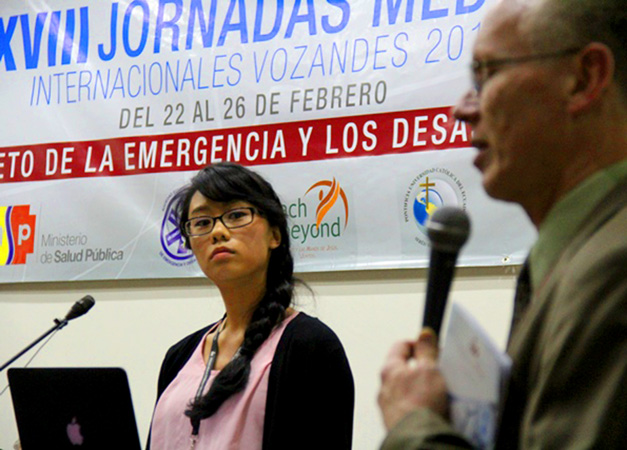MENU
(June 14, 2016 - stories by Ralph Kurtenbach) Themed “The Challenge of Emergency and Disaster,” the 28th Jornadas Médicas (Reach Beyond’s annual medical conference) in Ecuador preceded by less than two months a 7.8-magitude earthquake that left some 660 people dead and thousands wounded. Hundreds of buildings in two provinces were also flattened, including a hospital in the coastal province of Manabí.
The organization’s Hospital Vozandes-Quito (HVQ) co-sponsored the event along with other institutions, including Ecuador’s Ministerio de Salud Pública (Ministry of Public Health or MSP).
 This year’s event was held Feb. 22-26 at the mission’s facilities in Quito. On April 16 the killer quake struck Ecuador’s coastal area. Within days the first emergency medical response team from HVQ was dispatched, and subsequently additional teams saw to the medical, psychological and spiritual needs of quake victims. The teams went out at the invitation of the MSP.
This year’s event was held Feb. 22-26 at the mission’s facilities in Quito. On April 16 the killer quake struck Ecuador’s coastal area. Within days the first emergency medical response team from HVQ was dispatched, and subsequently additional teams saw to the medical, psychological and spiritual needs of quake victims. The teams went out at the invitation of the MSP.
Jornadas is considered the core academic event of HVQ, which in June celebrated an anniversary of the founding of its medical education program.
José Luis Paguay, a paramedic who attended this year’s conference, said he learned enough in the first few days of the conference to begin applying to his weekend shift in pre-hospital triage and transport work at a hospital in Quinindé. He also found useful a talk on hypertension, a common ailment among Ecuadorians.
Some 360 medical professionals attended the event, according to Dr. José Luis Recalde, an event organizer and director of medical education at HVQ. “A great portion of the attendees came from Quito obviously,” he said. “However, because of favorable attention, we also had people from the coast—from [the provinces of] Manabí and from Guayas.”
Recalde said the 2016 event differed from earlier Jornadas in at least two ways. First, an examination on the final day explored how much they took away from the conference.
 “An examination was requested by those working in the public sector because there’s going to be an MSP standard for those attending conferences,” Recalde offered. “It would help them to upgrade their resume.”
“An examination was requested by those working in the public sector because there’s going to be an MSP standard for those attending conferences,” Recalde offered. “It would help them to upgrade their resume.”
Voluntary, the exam drew participation from half of the conferees, and of those, half scored seven of 10 or higher “so that was good,” he added.
Second, this year’s five-day event was not distributed via satellite across Ecuador as were past conferences.
“Unfortunately, our coalition member for the satellite release—the distance learning at the Universidad Técnica Particular de Loja (Technical University in Loja)—could not participate in the event because they changed their organization,” Recalde explained. “We hope that in the future they can return to participate because that was a valuable contribution.”
“What I would have liked,” said Paguay, “would have been additional practical work. The study is great; the theory is perfect, but what we also need is a bit more of the practice because medicine is done by direct contact with a patient.”
Recalde and the Jornadas organizing committee also increased the number of workshops by 10 to a total of 30.
A Reach Beyond paramedic, Darrell Holden, attended one such workshop in which ambulatory work’s history, its uses and best practices were explained and shown via a PowerPoint presentation. Afterwards, the group of attendees scrunched into the back of an ambulance to observe the vehicle’s medical equipment features as detailed by an HVQ ambulance driver.
After Ecuador’s recent earthquake, Holden accompanied Drs. Guevara and Trina Wisecup as well as the team leader, Hermann Schirmacher, to the coastal provinces of Esmeraldas and Manabí where they attended to hundreds of patients.
Visiting Nurse Says Receiving Sometimes Goes with Giving
Dying is one thing, according to nurse Joanna Fidel. She’s seen people die before. To die alone though—that is another matter.
Fidel works in the emergency room of Vanderbilt University Medical Center in Nashville, Tenn. As a guest speaker at Jornadas Médicas 2016 in Quito, she told of heartbreak and how God used the situation to teach her of Himself.
 Themes of emergency medicine and disaster response were amply explored in 52 lectures, about half of which were given by specialists from outside of Ecuador, including Fidel.
Themes of emergency medicine and disaster response were amply explored in 52 lectures, about half of which were given by specialists from outside of Ecuador, including Fidel.
She related that when a lung cancer patient in pulmonary distress arrived at the emergency room, “we tried a BIPAP, but we ended up having to intubate him.” (The former method delivers pressurized air through a mask to a patient’s airways whereas the latter does so through a tube introduced into the throat.)
With doubts about the patient’s survival, Fidel attempted to contact his daughter. “As a nurse,” Fidel said, “you give a lot of yourself to a patient. You will not take your lunch break—sometimes not even your bathroom break. You give a lot of yourself.”
The conference consisted of plenary sessions, forums and workshops that offer information on new developments, review of good practices, and break-out sessions with hands-on opportunities.
Valued by attendees for its continuing education credits and professional development, Jornadas Médicas holds at its base an opportunity to share the love of Jesus Christ with the Ecuadorian medical community. With Reach Beyond’s Dr. Roy Ringenberg interpreting into Spanish, a few guests—including Fidel—shared testimonies of living a Christian life.
 “I was beside the patient the whole night time, and I tried to comfort him. I just didn’t want him to die alone with no family,” she continued. “The patient eventually did die around 9:30 that night, and the family still wasn’t there. We weren’t able to contact them.”
“I was beside the patient the whole night time, and I tried to comfort him. I just didn’t want him to die alone with no family,” she continued. “The patient eventually did die around 9:30 that night, and the family still wasn’t there. We weren’t able to contact them.”
Afterwards, Fidel had a good cry privately in a back room. “In the ER as a nurse, you have this appearance that you need to be tough and you need to be strong to care for these patients,” said Fidel, “because if you cry every time something bad happens to your patient, you’re not going to get any work done.”
Returning to her area, she was greeted by a new patient who had come to the ER with toe pain.
“As I did my assessment, I did my best to hold [the grief] in,” Fidel related. “But he stopped me and took my hand. He started to pray for me and—sorry, telling you about this makes me cry—and said that God put me in this role because I have a strong heart to be able to care for someone.”
As the patient prayed, the nurse sobbed. “I felt like a failure because I was supposed to be the strong one, and here I was crying as he was praying,” she confided. “But through this situation God taught me that you do have to be strong and caring, and that He can show Himself through this patient by him praying.”
Source: Reach Beyond
The organization’s Hospital Vozandes-Quito (HVQ) co-sponsored the event along with other institutions, including Ecuador’s Ministerio de Salud Pública (Ministry of Public Health or MSP).
 This year’s event was held Feb. 22-26 at the mission’s facilities in Quito. On April 16 the killer quake struck Ecuador’s coastal area. Within days the first emergency medical response team from HVQ was dispatched, and subsequently additional teams saw to the medical, psychological and spiritual needs of quake victims. The teams went out at the invitation of the MSP.
This year’s event was held Feb. 22-26 at the mission’s facilities in Quito. On April 16 the killer quake struck Ecuador’s coastal area. Within days the first emergency medical response team from HVQ was dispatched, and subsequently additional teams saw to the medical, psychological and spiritual needs of quake victims. The teams went out at the invitation of the MSP.Jornadas is considered the core academic event of HVQ, which in June celebrated an anniversary of the founding of its medical education program.
José Luis Paguay, a paramedic who attended this year’s conference, said he learned enough in the first few days of the conference to begin applying to his weekend shift in pre-hospital triage and transport work at a hospital in Quinindé. He also found useful a talk on hypertension, a common ailment among Ecuadorians.
Some 360 medical professionals attended the event, according to Dr. José Luis Recalde, an event organizer and director of medical education at HVQ. “A great portion of the attendees came from Quito obviously,” he said. “However, because of favorable attention, we also had people from the coast—from [the provinces of] Manabí and from Guayas.”
Recalde said the 2016 event differed from earlier Jornadas in at least two ways. First, an examination on the final day explored how much they took away from the conference.
 “An examination was requested by those working in the public sector because there’s going to be an MSP standard for those attending conferences,” Recalde offered. “It would help them to upgrade their resume.”
“An examination was requested by those working in the public sector because there’s going to be an MSP standard for those attending conferences,” Recalde offered. “It would help them to upgrade their resume.”Voluntary, the exam drew participation from half of the conferees, and of those, half scored seven of 10 or higher “so that was good,” he added.
Second, this year’s five-day event was not distributed via satellite across Ecuador as were past conferences.
“Unfortunately, our coalition member for the satellite release—the distance learning at the Universidad Técnica Particular de Loja (Technical University in Loja)—could not participate in the event because they changed their organization,” Recalde explained. “We hope that in the future they can return to participate because that was a valuable contribution.”
“What I would have liked,” said Paguay, “would have been additional practical work. The study is great; the theory is perfect, but what we also need is a bit more of the practice because medicine is done by direct contact with a patient.”
Recalde and the Jornadas organizing committee also increased the number of workshops by 10 to a total of 30.
A Reach Beyond paramedic, Darrell Holden, attended one such workshop in which ambulatory work’s history, its uses and best practices were explained and shown via a PowerPoint presentation. Afterwards, the group of attendees scrunched into the back of an ambulance to observe the vehicle’s medical equipment features as detailed by an HVQ ambulance driver.
After Ecuador’s recent earthquake, Holden accompanied Drs. Guevara and Trina Wisecup as well as the team leader, Hermann Schirmacher, to the coastal provinces of Esmeraldas and Manabí where they attended to hundreds of patients.
Visiting Nurse Says Receiving Sometimes Goes with Giving
Dying is one thing, according to nurse Joanna Fidel. She’s seen people die before. To die alone though—that is another matter.
Fidel works in the emergency room of Vanderbilt University Medical Center in Nashville, Tenn. As a guest speaker at Jornadas Médicas 2016 in Quito, she told of heartbreak and how God used the situation to teach her of Himself.
 Themes of emergency medicine and disaster response were amply explored in 52 lectures, about half of which were given by specialists from outside of Ecuador, including Fidel.
Themes of emergency medicine and disaster response were amply explored in 52 lectures, about half of which were given by specialists from outside of Ecuador, including Fidel.She related that when a lung cancer patient in pulmonary distress arrived at the emergency room, “we tried a BIPAP, but we ended up having to intubate him.” (The former method delivers pressurized air through a mask to a patient’s airways whereas the latter does so through a tube introduced into the throat.)
With doubts about the patient’s survival, Fidel attempted to contact his daughter. “As a nurse,” Fidel said, “you give a lot of yourself to a patient. You will not take your lunch break—sometimes not even your bathroom break. You give a lot of yourself.”
The conference consisted of plenary sessions, forums and workshops that offer information on new developments, review of good practices, and break-out sessions with hands-on opportunities.
Valued by attendees for its continuing education credits and professional development, Jornadas Médicas holds at its base an opportunity to share the love of Jesus Christ with the Ecuadorian medical community. With Reach Beyond’s Dr. Roy Ringenberg interpreting into Spanish, a few guests—including Fidel—shared testimonies of living a Christian life.
 “I was beside the patient the whole night time, and I tried to comfort him. I just didn’t want him to die alone with no family,” she continued. “The patient eventually did die around 9:30 that night, and the family still wasn’t there. We weren’t able to contact them.”
“I was beside the patient the whole night time, and I tried to comfort him. I just didn’t want him to die alone with no family,” she continued. “The patient eventually did die around 9:30 that night, and the family still wasn’t there. We weren’t able to contact them.”Afterwards, Fidel had a good cry privately in a back room. “In the ER as a nurse, you have this appearance that you need to be tough and you need to be strong to care for these patients,” said Fidel, “because if you cry every time something bad happens to your patient, you’re not going to get any work done.”
Returning to her area, she was greeted by a new patient who had come to the ER with toe pain.
“As I did my assessment, I did my best to hold [the grief] in,” Fidel related. “But he stopped me and took my hand. He started to pray for me and—sorry, telling you about this makes me cry—and said that God put me in this role because I have a strong heart to be able to care for someone.”
As the patient prayed, the nurse sobbed. “I felt like a failure because I was supposed to be the strong one, and here I was crying as he was praying,” she confided. “But through this situation God taught me that you do have to be strong and caring, and that He can show Himself through this patient by him praying.”
Source: Reach Beyond
